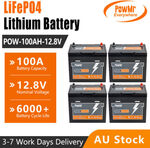If you want more than one battery use this listing: https://www.ebay.com.au/itm/156283987550 (for 4 they're $163 each)
Specs and such are here: https://powmr.com/products/lithium-battery-100ah-12-8v
As with all cheapie LiFePO4 batteries the specs are a little questionable, it is what it is…
These cheapie LiFePO4 batteries 'seem ok', I purchased a 200Ah one a while back, the capacity seems all good, initial testing using a Victron Smart-shunt to measure things, draining it down to 12v gave me 195.5Ah (12.11v resting voltage, roughly 10%), recharging it to 14v = 199Ah.. (I don't push my batteries to the extremes)
This company sell a lot of solar controllers, inverters and such, I suspect they're like Renogy and they just slap their name on gear made by other companies, but at least they have a name and a lot of sales, unlike a lot of the super-cheap battery sellers these days…
eBay code T&C's: https://pages.ebay.com.au/buyer_coupons/2025/mcbt20/






Wow, so low.
Let’s roll the dice, I have been in the market..